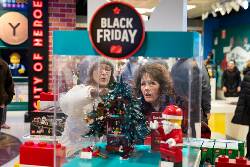NEW YORK (AP) — Black Friday no longer tempts people to leave Thanksgiving tables for midnight mall runs, but the annual sales event still brings more shoppers into stores than any day of the year and rules as the U.S. retail industry's unofficial start of the holiday shopping season.
This year's kickoff arrived as consumer confidence in the U.S. economy fell this month in the aftermath of the federal government shutdown, weak hiring and stubborn inflation, according to a report The Conference Board issued Tuesday.
Despite the economic uncertainty, shoppers went hunting Friday morning for the deals that retailers traditionally have reserved for the day after Thanksgiving.
At Macy’s Herald Square flagship store in New York City, customers who streamed in soon after the store opened at 6 a.m. found deep discounts on clothes, shoes, linens and cosmetics. The footwear department had products selling for 40% to 50%.
Nicholas Menasche, 19, from Queens, New York, shopped with his mother for shoes and clothing, and planned to head next to Best Buy for video games. Menasche, an intern at a bank, said he expected to spend around $1,200 this year on his holiday shopping, roughly the same amount as last year.
“It’s a great tradition," he said. "The stores are open really early.”
Both the massive Mall of America in Bloomington, Minnesota, and Westfield Garden State Plaza in Paramus, New Jersey, reported strong customer traffic on Friday and said Black Friday would once again rank as their busiest day of the year.
“We are off to a great start,” said Jill Renslow, Mall of America's chief business development and marketing officer.
The line to enter the shopping and entertainment center started forming at 3 p.m. on Thursday, Renslow said. About 14,000 visitors had entered within an hour of the mall's 7 a.m. opening, she said.
“We are tracking one of our best Black Fridays ever,” she added.
Many retail executives have reported customers becoming more discerning and increasingly focused on deals while at the same time remaining willing to splash out for important occasions, creating a potential halo effect that might keep financial worries from discouraging holiday shoppers.
Some retailers accelerated shipments of merchandise before the Trump administration's tariffs on imported products took effect or decided to absorb some of the tax costs instead of raising prices for customers.
Toys, baby products, housewares, and team sports equipment have been among the retail categories with the biggest price increases since April, according to market research firm Circana. Marshal Cohen, the firm's chief industry advisor, said the malls he visited on New York’s Long Island and in New Jersey on Friday grew busier as the day went on.
Target drew long lines for its 6 a.m. opening by offering the first 100 customers free tote bags “filled with goodies” and the chance to win a prize product worth over $99, Cohen noted. Otherwise, “gone is Black Friday as we know it,” he said. “There’s no sense of urgency.”
Holiday discounts leading up to Black Friday started a little later than last year, but Friday’s sales ended up being comparable, Renslow said. Bath & Body Works was especially packed, she said. Another brand that drew in customers was Skims, a loungewear and underwear business founded by celebrity Kim Kardashian, she said.
Westfield Garden State Plaza let customers in an hour early instead of making customers wait outside in the frigid weather, but stores didn’t open their doors until 7 a.m. as planned, said marketing director William Lewis. Members of Generation Z mostly comprised the early crowd, but older customers came in later, he said.
“People are definitely buying,” Lewis said. “Most people are walking around with a shopping bag."
Shoppers appeared to have done research ahead of time and arrived with specific stores and items in mind and “know exactly where they are going,” he said. Beauty emporium Sephora and clothing stores Aritzia, Alo, Hollister and Lululemon were some of the popular destinations, according to Lewis.
Although Black Friday still reigns supreme as a magnet for in-store shopping, the ease of browsing and buying gifts online has eroded the event’s singular significance. Online purchases now account for more than 30% of total holiday sales compared to 15% in 2012, according to the National Retail Federation.
The growth in online sales also has been robust so far. From Nov. 1 to Nov. 23, U.S. consumers spent $79.7 billion, or 7.5% more than a year earlier, according to web tracking and analysis platform Adobe Analytics. They spent another $6.4 billion online on Thanksgiving Day, a 5.3% increase over last year, while taking advantage of better than expected deals, the firm said.
“Clearly, there’s uncertainty,” Mastercard Chief Economist Michelle Meyer said ahead of Black Friday. “Clearly, consumers feel on edge. But at the moment, it doesn’t seem like it’s changing how they are showing up for this season.”
...


